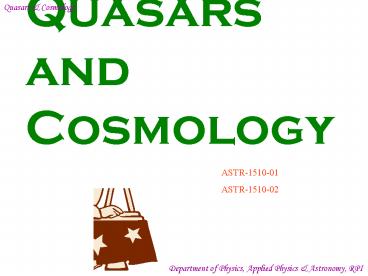Q - PowerPoint PPT Presentation
1 / 28
Title:
Q
Description:
Department of Physics, Applied Physics & Astronomy, RPI. Week 7 ... TAH DAH! Ned Wright 2000-2006. Image: NASA Wilkinson Microwave Anisotropy Probe (WMAP) ... – PowerPoint PPT presentation
Number of Views:22
Avg rating:3.0/5.0
Title: Q
1
Quasars Cosmology
Quasars and Cosmology
ASTR-1510-01 ASTR-1510-02
Department of Physics, Applied Physics
Astronomy, RPI
2
Week 7
- Galaxy Clusters
- Jones Lambourne
- Sections 4.1-3
- October 13, 2009
- 300 PM
- Darrin 330
Department of Physics, Applied Physics
Astronomy, RPI
3
Outline
- The Seeds of Creation
- Theories Galaxy Formation
- Evidence for the Bottom-Up Theory
- The Local Group
- Galaxy Clusters
4
Timeline of the Universe (a preview)
Image NASA Wilkinson Microwave Anisotropy Probe
(WMAP).
5
Cosmic Background Radiation
- Early Universe filled with photons (and other
stuff). - Before t400,00 yr the Universe was opaque.
- At 400,000 yr Universe suddenly became
transparent. - Photons could travel freely all the way to us!
- Picture of sky can reveal structure at t400,000
yr!
Image Homepage of NASA Wilkinson Microwave
Anisotropy Probe (WMAP)
6
A Map of the Terrestrial Sphere
- Mollweide projection.
- The whole Earth appears inside the oval.
- There is nothing outside the oval to see.
ãNed Wright 2000-2006.
7
A Map of the Sky
- Color stands for brightness in temperature
units. - Blue 0 Kelvin and red 4 Kelvin.
- Different densities would appear as different
colors. - But no structure is evident in this image!
- Early Universe was really, really, really smooth.
Data NASA COBE mission.
8
Does this look smooth to you?
No? Then how did we go from smooth to lumpy?
9
The Nobel Prize for PhysicsOctober 3, 2006
George Smoot UC Berkeley
John Mather NASA
Awarded for their discovery of the blackbody
form and anisotropy of the cosmic microwave
background radiation.
10
Cosmic Background Explorer (COBE)
- Conceived by John Mather AS A STUDENT!.
- Very sensitive measurements allow high contrast.
- Upper left same as last map.
- Upper right 400X increase in contrast.
- Lower left 2000X increase.
- Lower right 30,000X increase. TAH DAH!
ãNed Wright 2000-2006.
11
Behold The Seeds of All Creation
- Similar to previous but MUCH narrower range.
- Structure is present but VERY small amplitude.
- Higher (red) and lower (blue) densities are
evident. - But they differ only by 100 parts in a million!
- These are the seeds of all structure.
Image NASA Wilkinson Microwave Anisotropy Probe
(WMAP).
12
Galaxy Formation Problem
- Universe began 13.7 billion yr. ago.
- It had very, very, weak lumps.
- Today there huge lumps (galaxies).
- Goal theory for how lumps grew.
- Test explain lumps today.
13
Early Theory for Milky Way(Eggen, Lynden-Bell
Sandage, 1962)
- The Evidence
- orbits change slowly, so preserve memory of
formation! - different ages found in different places.
- old stars in bulge and halo young stars in the
disk. - Theory
- monolithic collapse of giant gas cloud.
- bulge and halo formed first while cloud still
round. - disk formed later after gas made pancake.
- Problems
- giant cloud is not a weak lump!
- at least 90 of mass (hence gravity) from dark
matter!
14
Modern Theories of Galaxy FormationI. Hot Dark
Matter
- Hot Dark Matter
- hot means speeds close to speed of light, c.
- most likely candidate neutrinos.
- Galaxy Formation Theories
- largest structures (galaxy clusters) form first.
- fragmentation makes smaller structures
(galaxies). - called the top down scenario.
15
Modern Theories of Galaxy FormationII. Cold Dark
Matter
- Cold Dark Matter
- cold means speeds much less than c.
- candidate axions, WIMPs,
- Galaxy Formation Theories
- smallest structures (galaxies) form first.
- mergers make larger structures.
- makes smaller structures (galaxies).
- called the bottum up scenario.
16
A Simulation with Cold Dark Matter Renyu Cen,
Princeton University
17
Colliding Galaxies The Antennae
Ground-Based
Hubble
Image NASA/ESA/HST
18
Colliding Galaxies The Mice
19
Colliding Galaxies(?) Stefans Quintet
20
X-Ray Emission from Stefans Quintet
21
The Result of a Merger
Galaxy ESO 510-G13
Image NASA/ESA/HST Produced by C. Conselice
(STScI)
22
Groups and Clusters of Galaxies
- Bottom-up theory predicts galaxy interactions.
- Mergers are just one kind.
- Another possibility groups of galaxies.
- Definitions
- Cluster gravitational bound collection of
galaxies - Group a cluster with Nlt50 galaxies.
23
The Local Group (N _at_ 30)
Zoom
Images http//www.atlasoftheuniverse.com/virgo.ht
ml
24
Hickson Compact Group (N _at_ a few)
N a few
25
Coma Cluster (N gt1000)
26
Abell 2218 (N gt 1000)
27
Abell 1689 Rich Galaxy Cluster Such
Clusters contain giant elliptical galaxies in
the center.
28
Clusters Summary
- Vast majority of galaxies (field galaxies)
- NOT in clusters.
- Clusters do NOT vary much in size
- all have radii of about 2 Mpc.
- They DO vary greatly in richness.
- Small clusters (groups) have only a few
- members.
- Rich clusters can have 10,000 galaxies.
- Implications galaxies are tightly packed in
- rich clusters.
- So there should be more mergers there.































